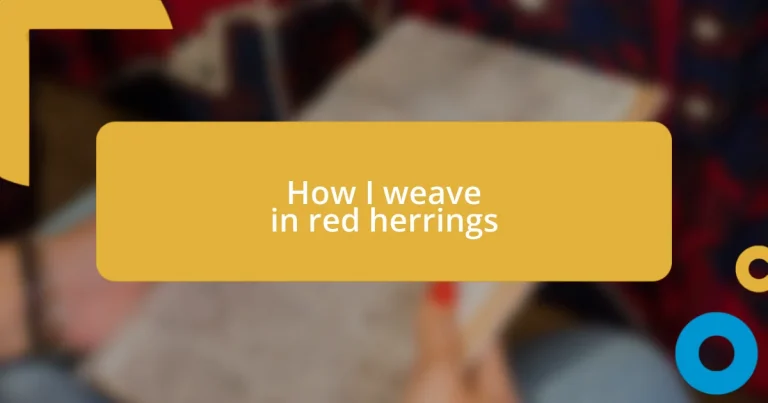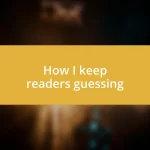Key takeaways:
- Red herrings serve as effective literary devices that distract from the main plot, creating suspense and enhancing storytelling through misdirection.
- Successful integration of red herrings involves techniques like creating relatable characters, planting misleading clues, and carefully timing revelations to maintain intrigue.
- Common pitfalls include overusing red herrings, failing to develop characters, and improper timing, which can confuse readers and diminish emotional impact.
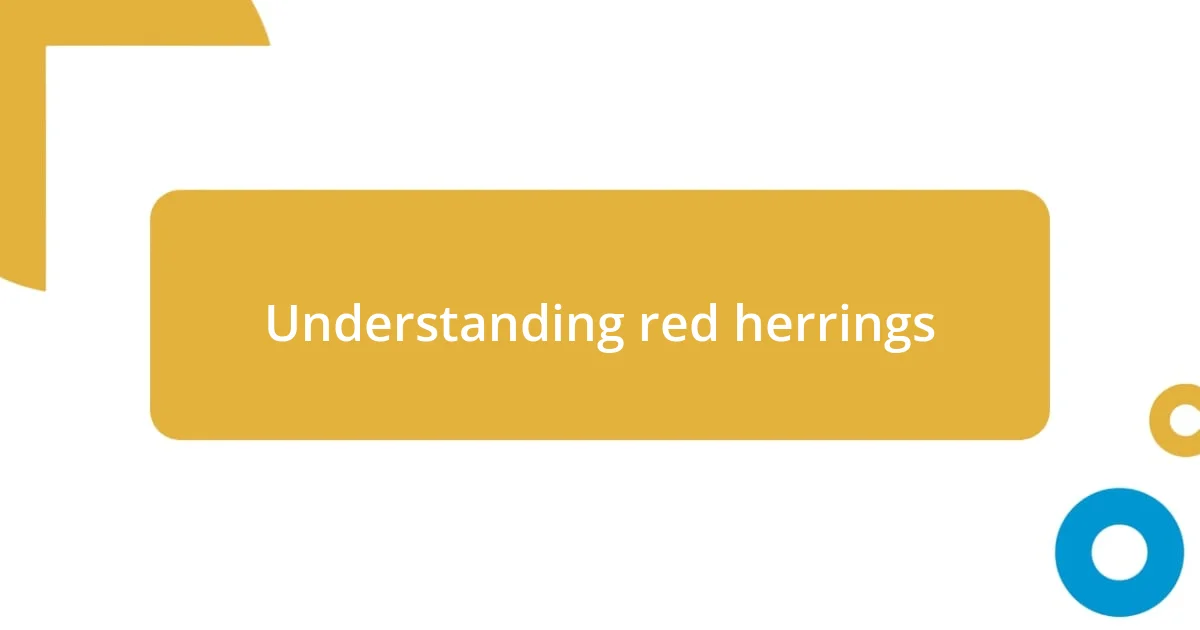
Understanding red herrings
Red herrings are fascinating literary devices that distract readers from the main plot or argument. I remember reading a mystery novel where the author led me down a rabbit hole, focusing on a seemingly crucial character while the real culprit was hiding in plain sight. It’s intriguing how a cleverly placed distraction can heighten suspense and deepen the mystery, isn’t it?
What’s interesting is that red herrings aren’t limited to fiction. In everyday conversations and debates, people often introduce irrelevant information to steer discussions off course. I’ve seen this happen in heated arguments—when one person brings up a past mistake to deflect from the current issue. It makes me wonder: how often do we fall for these distractions without realizing it?
Furthermore, the emotional impact of red herrings can be quite strong. They can evoke frustration, surprise, or even delight when the truth finally unravels. Have you ever felt a mixture of relief and astonishment when a plot twist caught you off guard? That feeling is part of what makes reading and storytelling so engaging, as the journey through misdirection ultimately leads to a deeper understanding of the narrative.
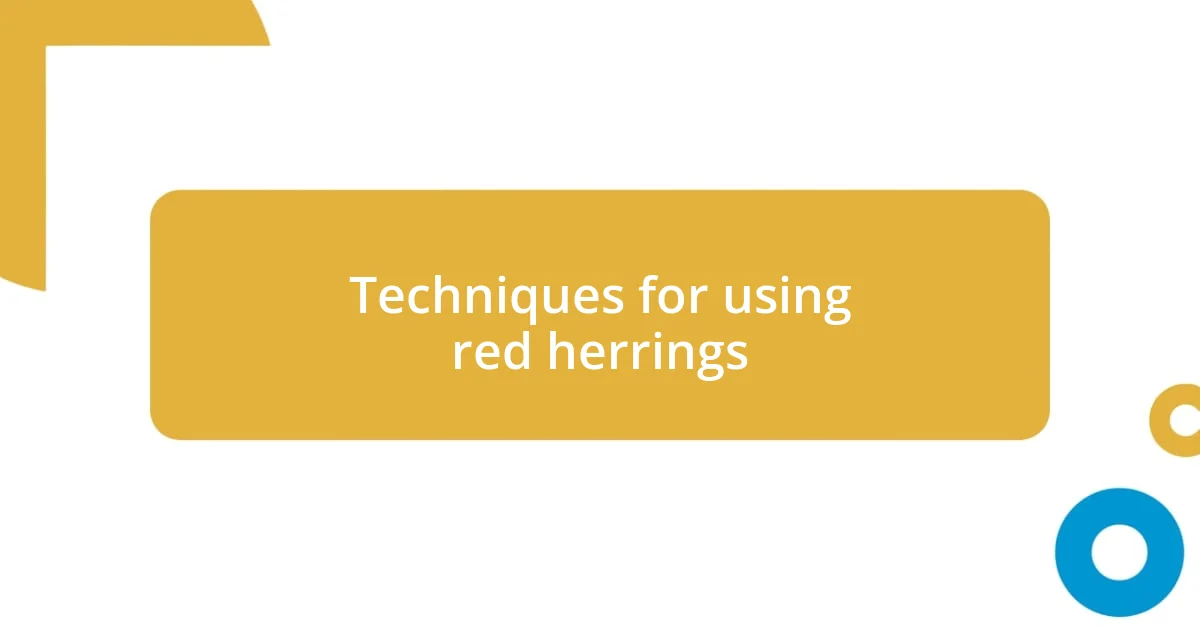
Techniques for using red herrings
When incorporating red herrings, a few techniques can make them particularly effective. For instance, subtly linking the distraction to the main plot can create a sense of plausibility. I recall watching a thrilling detective series where an innocent bystander was painted as the main suspect. The writers layered in clues that seemed significant at first, but ultimately led to the real twist. This intentional misdirection not only kept me guessing but also deepened the narrative’s complexity.
To maximize the impact of red herrings, consider these techniques:
- Create relatable characters: Making the red herring character someone readers empathize with can heighten emotional stakes.
- Plant misleading clues: Drop hints that point toward the distraction, ensuring they’re compelling yet irrelevant.
- Use foreshadowing: This can subtly suggest future plot developments while leading readers astray.
- Time your revelation well: Unveiling the truth at a climactic moment creates a stronger emotional response.
Reflecting on these techniques, it’s clear how much skill goes into crafting a compelling misdirection. I remember chatting with friends about our favorite books and realizing how some of the best stories leverage these tactics to keep us engaged and invested. It’s a bit like playing a game of chess; each move has to be calculated to lead the reader where you want them to go without revealing your true intention too soon.
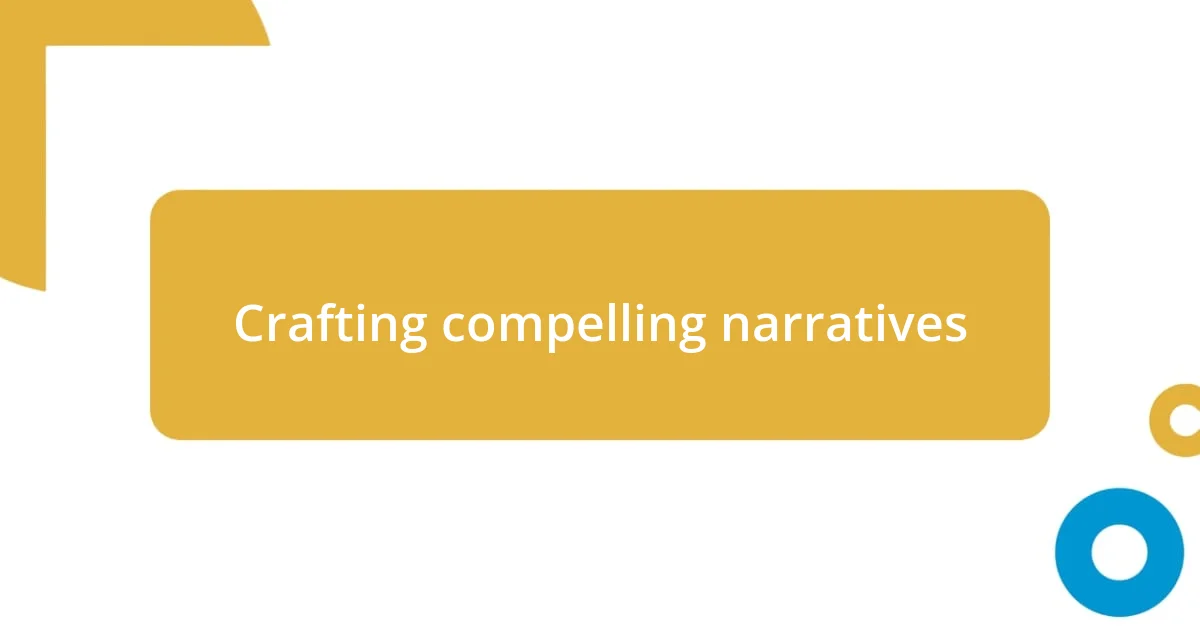
Crafting compelling narratives
Crafting compelling narratives often involves weaving intricate layers that captivate readers, pulling them into the story. I’ve found that striking the right balance between suspense and revelation is essential. For instance, in a novel I once read, the author expertly introduced a subplot that seemed unrelated, yet it resonated perfectly with the main storyline. When the connections were unveiled, it not only surprised me but also made me appreciate the craftsmanship behind the narrative structure.
Another powerful technique is developing a strong sense of atmosphere that complements the red herrings. There was a time when I was engrossed in a gothic thriller, enveloped in a fog-laden setting filled with eerie sounds and shadows. The environment itself became a character, influencing how I perceived the twists and turns of the plot. It highlights how the emotional tone of a story can elevate the experience and create a more immersive reading journey.
Moreover, pacing plays a crucial role in maintaining intrigue. I recall a short story where the author spent several pages unfolding a seemingly mundane event. Suddenly, a twist revealed a hidden motive—a brilliant tactic that left me reflecting on narrative pace long after I finished reading. It makes me ponder how slowing down or speeding up the story can manipulate tension and anticipation brilliantly.
| Aspect | Description |
|---|---|
| Balancing Suspense | Layering subplots creates a rich tapestry that enhances the main story. |
| Atmospheric Influence | A strong setting shapes perceptions, making twists more impactful. |
| Pacing Techniques | Manipulating timing can heighten emotional responses to key revelations. |
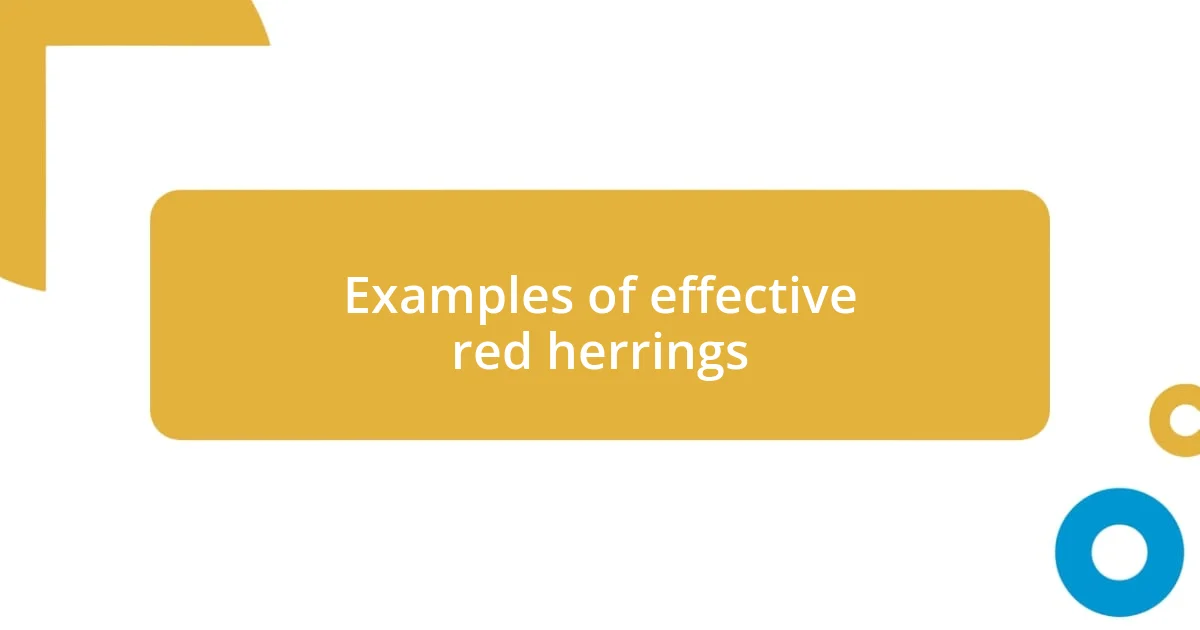
Examples of effective red herrings
One effective example of a red herring comes from a mystery novel I recently devoured. The author introduced a seemingly minor character—a local historian—who appeared to be a key player in unraveling the central mystery. Initially, I was convinced that his insights would lead to crucial breakthroughs, only to later discover he was merely a distraction while the true antagonist lurked in the shadows. This clever twist took me by surprise, reminding me how crucial it is to engage readers with characters that seem significant but ultimately serve a different purpose.
In another instance, I recall a movie where a valuable piece of jewelry went missing at a lavish party. The filmmakers artfully directed attention towards a sneaky guest, complete with over-the-top behavior. My mind raced with speculation as I invested in this character’s backstory and motives. When the truth came to light—revealing a more subtle betrayal by someone far closer to the protagonist—I couldn’t help but admire the cleverness of the misleading clues that kept my suspicions off the true culprit.
Then there’s the time I read a psychological thriller that played with my expectations regarding a relationship between two main characters. Throughout the story, there were repeated hints of jealousy and rivalry, which led me to draw faulty conclusions about their dynamic. When the final, shocking revelation emerged, it turned the entire subplot upside down, leaving me with a mix of disbelief and awe. Have you ever caught yourself fixating on the wrong details, only to find that the truth was woven intricately all along? It’s a powerful reminder of how expertly crafted red herrings can keep us on our toes.
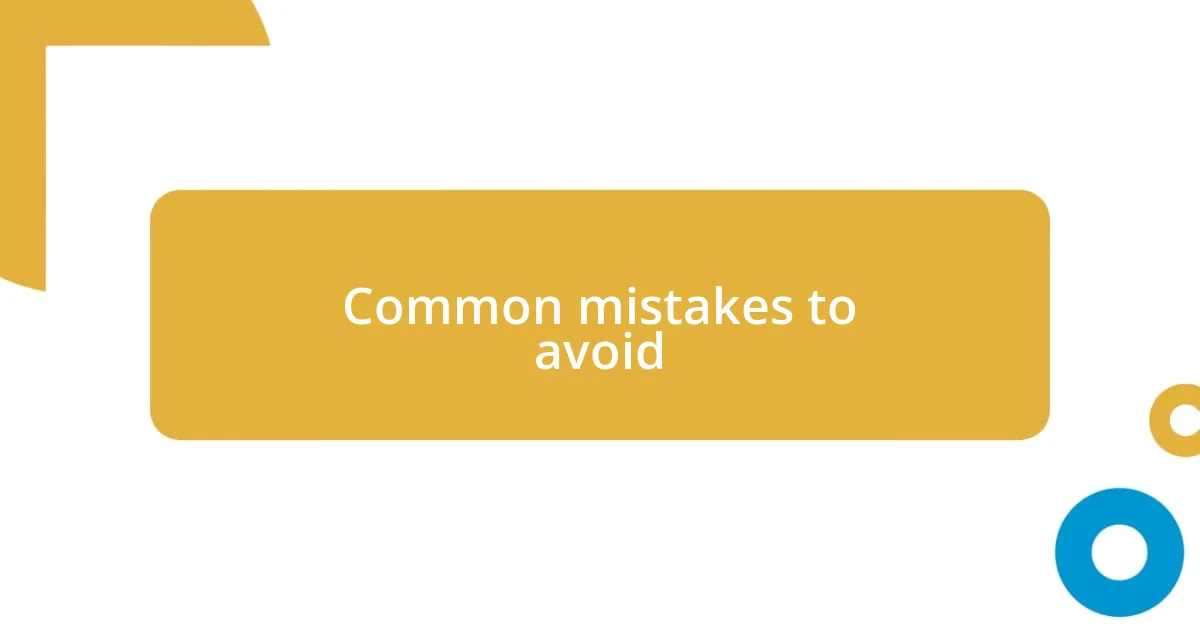
Common mistakes to avoid
One common mistake I often see is relying too heavily on red herrings without sufficient context. A few years ago, I read a thriller where the author dropped multiple misleading clues, but they felt random and disconnected. As a result, I found myself confused rather than intrigued—too many distractions can dilute the impact of the main plot. Have you ever felt overwhelmed by too many twists? It’s crucial to weave your red herrings seamlessly into the fabric of the story so that they enhance rather than muddle your narrative.
Another pitfall is failing to develop the red herring characters or elements adequately. I remember watching a crime drama where a side character was introduced as a potential suspect but was never fleshed out. When the big reveal came, I couldn’t connect emotionally, simply because I hadn’t invested in their storyline. It’s important to make every character, no matter how tangential, feel relevant; otherwise, the surprise loses its punch. What if the reader doesn’t care about the distraction? It serves as a gentle reminder that depth matters.
Timing is equally critical. I once came across a story that dropped a significant clue too late in the game. All the earlier red herrings suddenly felt like a lead-up to something that lacked adequate tension. As a reader, I appreciated the cleverness of the twist, but I was left unsatisfied—like finishing a meal and wishing for just one more bite. Balancing when to reveal hints or distractions can be tricky, but it’s essential to maintain that tantalizing sense of suspense throughout the journey. Do you think about how the timing of your reveals can shape the reader’s experience? I certainly do now!
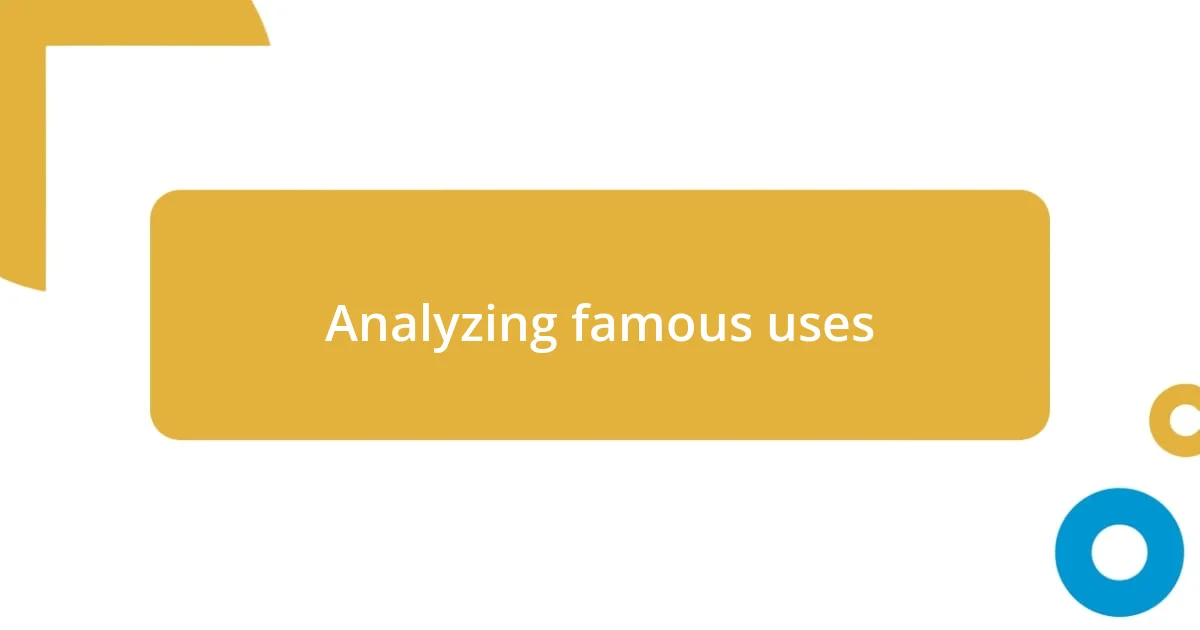
Analyzing famous uses
When I think about effective red herrings, Agatha Christie’s “Murder on the Orient Express” comes to mind. Christie masterfully leads you down one path with the character of Ratchett, whose backstory seems pivotal to the murder mystery. However, as the layers unfold, you realize the true brilliance lies in focusing on the passengers themselves, creating a web of deceit that keeps you guessing until the very end. Did you find yourself changing your theories as the clues unfolded, just like I did?
Another example I cherish is the TV series “Breaking Bad,” where the character of Saul Goodman initially appears to be a mere comic relief. His outlandish legal tactics mislead viewers into thinking he’s just a quirky sidekick. Yet, as the story progresses, it becomes clear that he holds significant sway over some pivotal plot points. I found myself chuckling at his antics while subconsciously underestimating his depth. Isn’t it fascinating how a well-placed distraction can shift our focus, enhancing the narrative’s complexity?
In my reading journey, I often reflect on the series “The Girl with the Dragon Tattoo.” The intricate plot twists kept me engaged, but it was the red herrings that truly created an immersive experience. For instance, potential leads were presented and discarded, shaping my expectations and keeping me on my toes. It left me wondering how much I had overlooked in my pursuit of the truth. Have you ever sensed that thrill of being outsmarted by the author? That’s the magic of red herrings—they clean your thoughts yet mess with your expectations in the most delightful way.
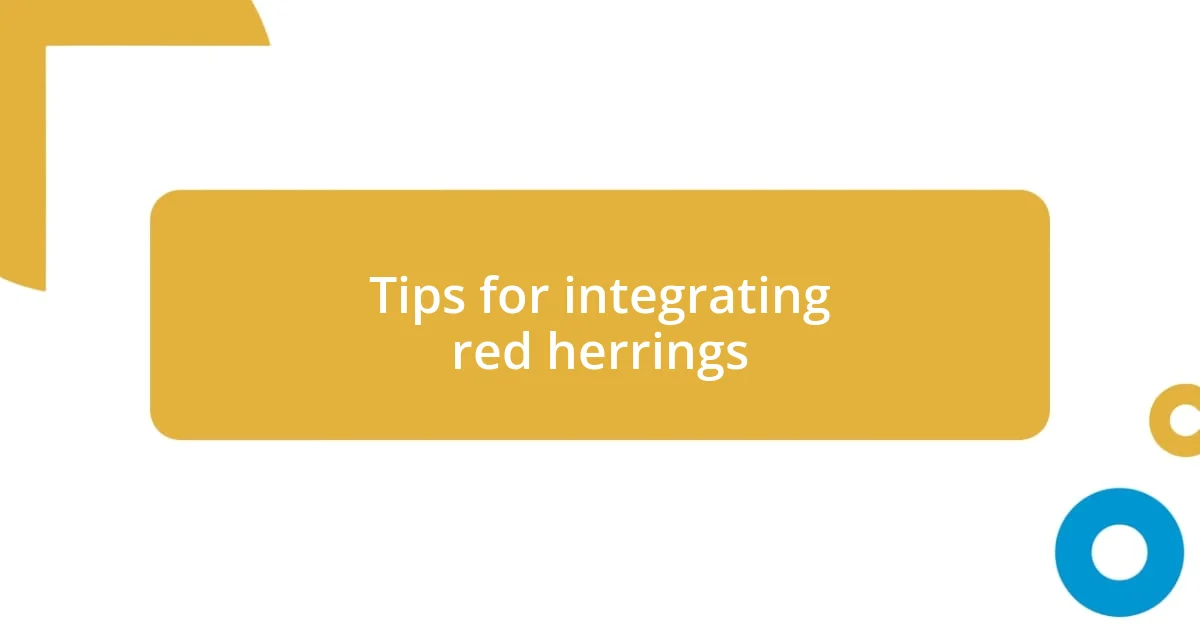
Tips for integrating red herrings
When integrating red herrings, I find that subtlety goes a long way. For instance, in one of my own stories, I introduced a seemingly innocent character who only appeared in a couple of scenes. Readers were quick to form opinions about them, which was the exact response I hoped for. The key is to sprinkle these distractions lightly throughout the narrative, allowing readers to engage without becoming overwhelmed. Have you ever noticed how a hint can evoke curiosity while still maintaining an air of mystery?
Building emotional stakes is crucial, too. In a project I once worked on, I created a red herring that connected deeply with the protagonist’s backstory. This character’s motivations mirrored the main plot, making the distraction feel vital rather than ancillary. When the big reveal came, it not only shocked the audience but also resonated with their emotions. Isn’t it amazing how a red herring can be both a decoy and a deeper insight into character development?
I also believe in the importance of layering your clues. In my experience, hinting at multiple possibilities can keep the reader guessing without sacrificing the main story arc. I remember a workshop where we explored this technique. By presenting two or three plausible distractions at once, I kept my audience debating among themselves. What’s more satisfying than a twist that feels earned? Balancing these elements effectively is a dance, but when done right, it enhances the reader’s journey immensely.












